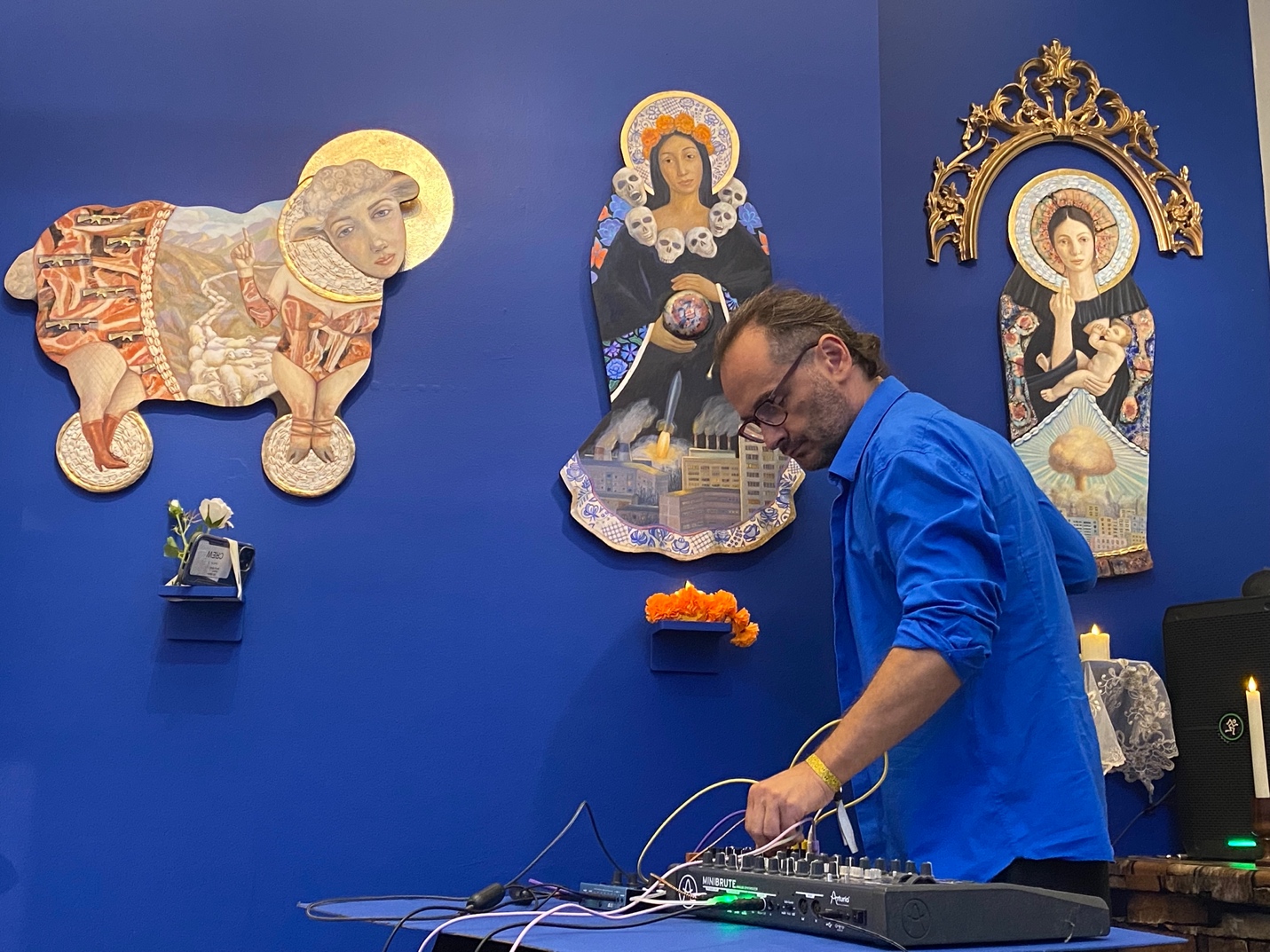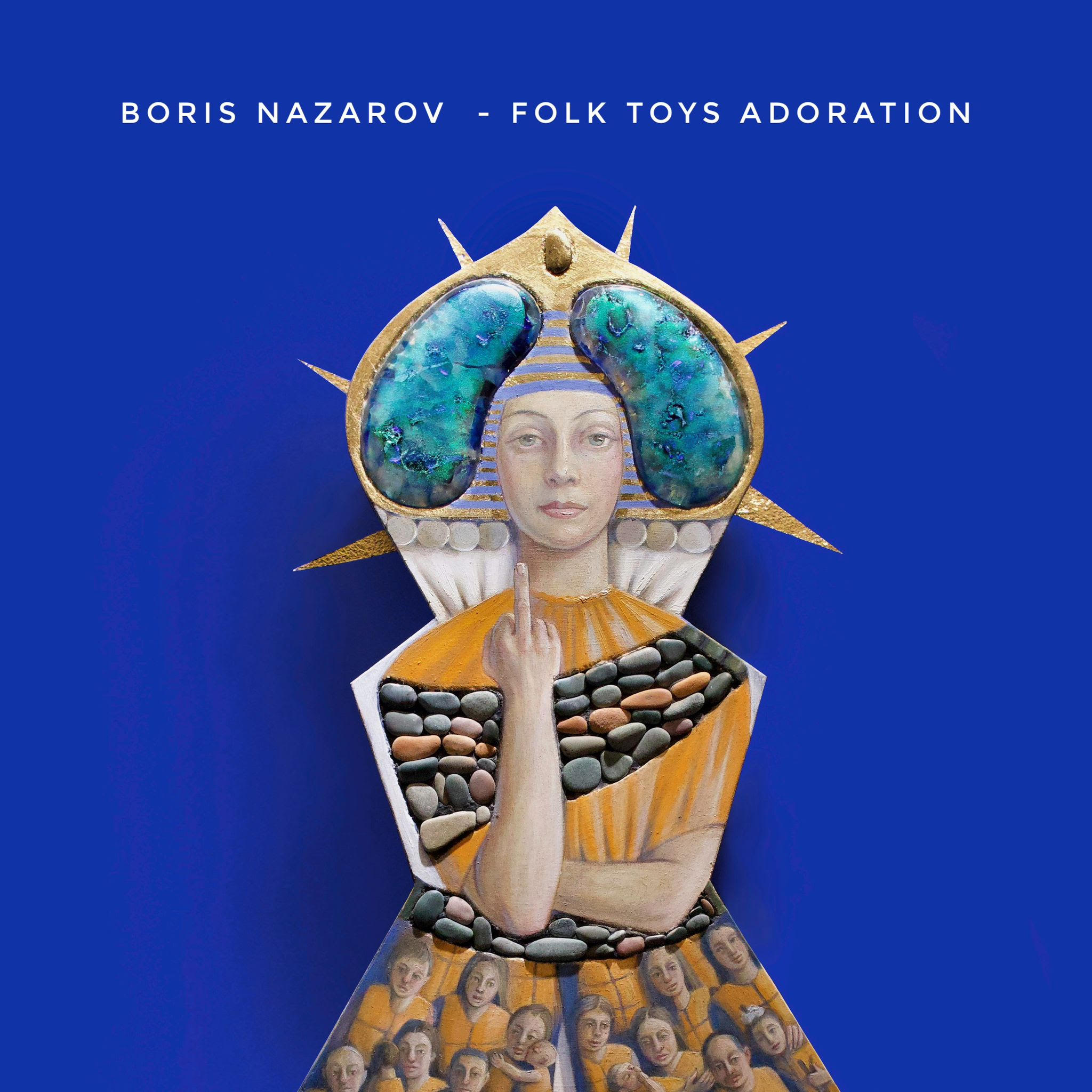Folk Toys Temple, Where Sound Art Guides Epiphanies


The curator-driven fair SPRING/BREAK serves as a launchpad for both seasoned and emerging professionals. This year marked a curatorial debut for Boris Nazarov—a pioneer in electronic music of the 1990s—for the booth “Folk Toys Temple” featuring his polyphonic soundscape and art works by Viktoriya Basina. Arguably, sound art is one of the least represented art forms at the fair and this showcase was dense considering its technical dexterity and I would imagine it impressed most regular art goers.
At once serious and simultaneously humorous, the installation features animals and the female doll figures in styles loosely based on Byzantine iconography. While at first seeming whimsical and attractive, the figures allude to warfare, militarism, consumption, and misogyny. What is currently idolized and glorified actually leads to incessant violence and intolerance. With a clear feminist message, Madonna is giving the middle finger in one work and the animals depicted—a horse, pig, chick, cow—are a mix of endearing and not-so-polite terms for women. These animals are also used for sacrifice in many cultures—the cow, highlighted by Laksmi Rivera Amin in Hyperallergic is objectified, sexy, while advertising itself as kosher and halal. Referring to the religious Jewish and Islamic meat preparations indicates that this societal critique encompasses the globe.
While creating music for “Folk Toys” Nazarov was inspired by the Byzantine iconographic styles of Basina’s work. He evokes a religious or anti-religious feeling, depending on each visitor’s worldview. I for one, an atheist, found the works to be humorous and mocking—decidedly anti-religious. The music was intriguing and hard to pin down. “I wrote several pieces performed in the style of pseudo-religious music, as well as several noise works.” Nazarov told me about the sound piece. These two types of musical works sounded simultaneously, from different speakers creating a macro polyrhythmic soundscape in the booth. ”As a counterpoint to the pseudo-religious musical mood I layered short 15-minute experimental improvisational noise sets on modular synthesizers in the piece,” Nazarov continued The duo used SPRING/BREAK as a testing ground for the installation which they intend to stage in a much larger format.

Deeply engaged with art history, the walls of “Folk Toys Temple” were painted in a blue inspired by the ultramarine pigment used in the Padua fresco by proto-renaissance artist Giotto. Some of the pieces are made of fired glass with inlaid stone; in them, the classical art training Basina attained comes through. The work is certainly not celebratory but rather points to the oppressive nature of religion, and society overall—“critiquing a culture obsessed with symbols of wealth, weapons, and entrenched gender roles,” Nazarov explains.
At SPRING/BREAK Nazarov experimented with sound to deepen engagement. Four speakers are playing a four-channel sound work, it is beautiful but hard to follow as the voice are encrypted. This encrypted voice track that features Basina’s 10-year-old daughter creates an eerie but beautiful sound; this is how Nazarov envisions angels singing. To create this sound Nazarov used MaxMSP which, through code, finds polyphonic sounds. The sound creates an intimate experience as the sound moves around the room; conducive to epiphanies to unfold. By evoking a religious site, Nazarov ushers his audience into a space of reflection.

Although “Folk Toys” is Nazarov’s first curatorial project, it is not the first time he has worked with Basina. Earlier this year, Basina created a mural in her home neighborhood of Ditmas Park bringing different cultures together on one canvas—material cultural objects from Haiti, Togo, Bangladesh, Ukraine, Sweden, Russia, and seventeen other cultures are depicted. For the opening party, Nazarov, supported by Flatbush Development Corporation, put together a mix that merged folk music with techno and house, helping people connect with their own ancestry and the ancestries of their neighbors. Nazarov also wrote the score for a documentary about the Basina, “For Feeling,” by the Swedish New York-based director and cinematographer Eric Jenkins-Sahlin. Nazarov also scored the director’s next documentary “Forbidden Pond” that will premiere at DocNYC on November 11th.
In the music industry, Nazarov is a tour-de-force. Nazarov has lent his talents to Goatika Creative Lab where he played with Björk’s percussionist Pete Locked and King Crimson and later Peter Gabriel’s bass player Tony Levin. He has always been on the cutting edge of sound. “I still get letters from guys who love or write electronic music saying that they discovered electronic music through projects in which I participated. When you inspire people to be creative, there is a tangible sense to your mission,” he explains.
Between 1995 and 2010 Nazarov recorded six records and played more than 500 shows together with Arkady Marto from Moscow Grooves Institute. They toured in Russia, Ukraine,the Baltic countries, Poland, Germany, France, and Japan and played as an opening act for Massive Attack and Dave Gahan (from Depeche Mode). Their stylistic range revolved around eclectic electronica from experimental dark ambient and shoegaze art-rock to tech-house music and drum and bass. “Often guest artists and folk musicians were featured in our records and gave our music a warmer sound,” he explains.
“The collapse of the USSR made it possible for anyone to make experimental electronic music, which was impossible in the Soviet era. Immediately the musical landscape blossomed wildly and there was so much interesting music,” To meet the needs of creative enthusiasm Nazarov founded the music label Citadel Records in 1997. The label released some 100 releases of electronic music of various types. He represented Russian electronic music at Midem (France), PopKomm (Germany), and Amsterdam Dance Event (Holland), among other fairs and festivals. “During this time, the post-Soviet music scenes spread like wildfire finding oxygen through salutary neglect beneath the recently dismantled totalitarian state,” he continued. Today more than 250 tracks from his music label can be heard on Citadel Record’s SoundCloud.

To bring more sound into curating and the field of visual art, Nazarov founded the New York Audio Video Institute (NYAVI) which designs live performance multimedia spectacles, creating fusions of sonic and visual art. Now that SPRING/BREAK is over Nazarov is engineering the music to change from a chamber single-voice piece to solemn polyphonic liturgical music that follows its visitor who will engae with the work in a larger space. For those who want to hear more before then, the “Folk Toys Adoration” soundtrack was just released on Apple Music, Spotify, and other digital music platforms.
You Might Also Like
Post-Breakup, Artist Duo Nathalie Djurberg and Hans Berg Present Their Most Intimate Work
Jeanette Andrews Blends Artificial Intelligence and Magic in “Taken by Artificial Surprise”
What's Your Reaction?
Anna Mikaela Ekstrand is editor-in-chief and founder of Cultbytes. She mediates art through writing, curating, and lecturing. Her latest books are Assuming Asymmetries: Conversations on Curating Public Art Projects of the 1980s and 1990s and Curating Beyond the Mainstream. Send your inquiries, tips, and pitches to info@cultbytes.com.

